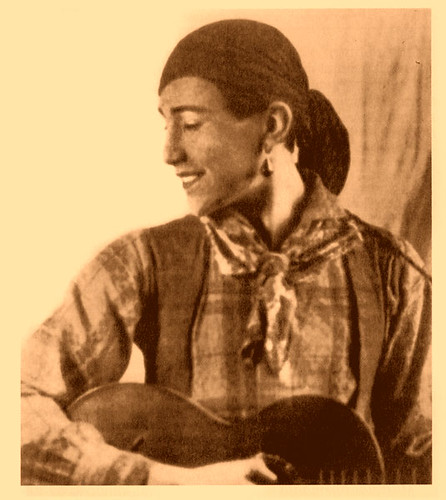This is a tinted version of a photo found in an article by Anu Koivunen on the concepts of stardom and women as consumers of film and filmstars in the 1920's, which features our favourite Finnish Tatar in a major role.
Under the name Teuvo Tulio, Theodor Tugai became an influential film director who put a passionate stamp on the Finnish film industry in the 1930's and 1940's. His early career as "the Finnish Valentino" is less well known. In Mustalaishurmaaja ("Gypsy Casanova", 1929), the 16-year-old Tugai plays Gypsy leader Manjardo. Koivunen describes how the camera focuses on him as on a beautiful object, with closeups of his half-shut eyes. His makeup and costume are chosen to accentuate this - dark skin, enhanced lips, jewellery, accentuated waist, occasionally shirtless... You get the picture.
But to be a desirable object for women - paradoxically put his masculinity into question. Watching and looking is an act of power, to be looked at is to become passive, traditionally feminine. But Manjardo does both. In the movie plot, he is a fiery character who is forced to accept an arranged marriage. He is an ethnic other who is both attracive and repellent (although his love interests in the movie are all "Gypsies", too - Koivunen hints that it would have been less acceptable to show "Finnish" women openly desiring a man). Two women, Glafira and Akris, fight for his attention, but the film finds a more conventional solution - Manjardo ends up with the motherly and caring Esmeralda, who tends to his wounds.
Next time, I will write more about the reception of Tugai's film persona among film critics, and the decline of the "Valentino" type.
Source:
Anu Koivunen: "Näkyvä nainen ja 'suloinen pyörrytys'", Vampyyrinainen ja Kenkkuniemen sauna - Suomalainen kaksikymmenluku ja modernin mahdollisuus ["Vampire Woman and the Sauna of Kenkkuniemi - The Finnish 1920's and the Possibility of Modernity"] Ed. Tapio Onnela, SKS, Helsinki 1992
Cross-posted at Chirayliq





